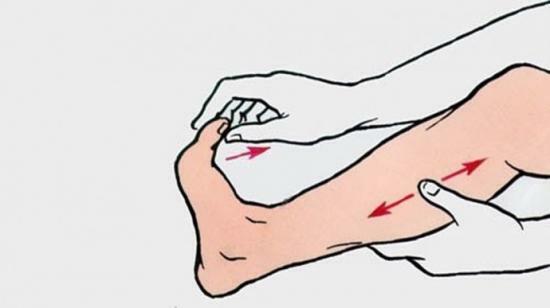Feet cramps at night, usual fatigue or a symptom of the disease?

Especially often suffer from this unpleasant phenomenon of elderly patients, which is associated with a number of age-related changes in the body.Most often, such cramps are a manifestation of muscle or nervous overwork, and do not pose a particular threat.
However, in some cases this may still be a manifestation of serious diseases, patients with whom need a thorough examination and as early as possible the start of treatment.What is characteristic: convulsions, being, as a matter of fact, a painful muscular spasm, are not always caused by disorders in the central or peripheral nervous system.
They may also be caused by disturbances in the normal functioning of the endocrine system, be due to lack of vitamins, occur at high body temperature( characteristic especially to pediatric), or caused by intake of some drugs.
In some cases, the cause of nighttime convulsions in the legs can not be determined even after a thorough examination.
Contents:
- What is convulsions and how do they occur?
- Classification seizures
- Lack of vitamins and minerals syndrome cramps, restless leg syndrome
- Cramps at night in the case of endocrine disorders
- Febrile convulsions in children
- disease Canavan and convulsions in children
- Epilepsy - especially convulsions inthis disease
- infectious and non-infectious lesions of the brain, accompanied by convulsions
seizures - what is it and what is the mechanism of their development?
This is not a consciously controlled painful contraction of smooth or striated muscles.As a rule, spasm is accompanied by a rather intense pain, as well as loss of function of the affected organ.In the case of spasms of the skeletal( transverse striated) musculature, there is a significant difficulty in the movements.

Pathogenesis seizures may be different:
- In the case of epilepsy occurs a so-called discharge gipersinhronny - simultaneous excitation of relatively large groups of nerve cells in the central nervous system.
- Increased excitability with convulsions may not necessarily be observed only with epilepsy, the cause of spasms may be other options for increasing the activity of segmental and suprasegmental structures of the central nervous system.
- Painful spasms can occur when the oxygen supply to neurons decreases or ceases.
- disorder in the functioning of nerve cells can be caused by a lack of vitamins, trace elements, glucose, which can be observed as in endocrine pathologies, and in poor nutrition.
possible situations in which can develop seizures, mechanisms and causes quite a lot, to determine what provoked their appearance in each case can only be a specialist.
Classification peculiarities
Depending on the peculiarities of muscle contraction in seizures, it is customary to single out several of their variants:
- Tonic.
- Clonic.
- Tonic-clonic.
- Myoclonic.
In clonic convulsions, muscle contractions occur, which alternate and relax them.Outwardly this has the appearance of fast and, as a rule, rhythmic movements.This state develops when the braking effect of the cerebral cortex on motor neurons located in the spinal cord decreases or is lost for some reason or another.
In the case of lesions of the extrapyramidal pathway, the clones of the foot or knee cap can be called up during the examination, which helps with the diagnosis.
The tonic variant is characterized by a constant contraction of muscles, without relaxation intervals, which lasts for a certain time, quite often quite long( duration depends primarily on the cause of the appearance of tonic convulsions).Tonic convulsions are most often affected by upper or lower extremities, but tonic convulsions can also be generalized.
Tonic-clonic convulsions are successively replacing tonic and then clonic muscle contractions.This variant is most typical for the so-called "large seizures" in epilepsy.
Myoclonal cramps are painless.Occur more often either at night, or during, or after a day's sleep.Spasm, as a rule, affects a few, or just one muscle.
Nocturnal cramps in case of lack of vitamins, magnesium, restless leg syndrome and cramp
Causing night convulsions of the lower and upper limbs can also be a shortage of vitamins important for the normal functioning of the tissues that form the nervous system.These are mainly vitamins of group B( primarily B6).
Magnesium deficiency can also contribute to the occurrence of nocturnal seizures.This chemical element plays an important role, both in the processes of transmission of the nerve impulse, and in the reaction of the muscles to it.First of all, magnesium prevents excessive intake of calcium in the muscle tissue, which can provoke a spasm.Also, seizures can occur when there is a lack of vitamin D in the body, as well as calcium.

A similar condition is corrected by the correction of the diet, as well as by the corresponding preparations that make up the shortage of vitamins and other necessary substances.
Leg cramps also occur in the syndrome of the crump.The mechanism of occurrence is not fully understood, but it is believed that causing these periodic cramps of calves may be a shortage of magnesium, can also occur as a consequence of squeezing the nerve root.With this disease, in case it is caused by mechanical compression of the nerve, it may be necessary, including surgical treatment.
Convulsions in the usual sense are not typical for restless legs syndrome.However, with this pathological condition, there can be observed so-called periodic movements of limbs that can resemble convulsions.Characteristic for restless legs syndrome is the intensification of manifestations in the evening and night.
Diseases of the endocrine system and convulsions at night
Of endocrine system diseases, convulsions are most common for hypoparathyroidism.This disease develops as a result of the lack of hormones of the pristine glands, which can often develop after operations on the thyroid gland - parathyroid glands are small, and in some cases, especially if the surgery for cancer and part of the anatomical landmarks does not work, they are accidentally removed.
However, deficiency of parathyroid hormone can be observed in inflammatory lesions, injuries, autoimmune processes, congenital maldevelopment of these endocrine glands.Due to the lack of a hormone, a decrease in the content of calcium in the blood plasma develops, simultaneously with what hyperphosphataemia occurs.This leads to increased excitability of both nervous and muscle tissue, which is manifested by tonic convulsions, which are often disturbed at night.
For the treatment of this condition, calcium preparations are used, both for intravenous and internal use, sedatives, as well as antispasmodic drugs.This or that quantity of phosphorus is contained in almost all foodstuffs, therefore it is recommended to take aluminum hydroxide, which to some extent reduces the amount of phosphorus absorbed in the digestive tract.
Such patients should regularly be observed by an endocrinologist, as well as an ophthalmologist, since such patients have a high risk of developing cataracts.
Febrile convulsions
Children with fever may develop so-called febrile seizures.Since the temperature usually rises in the evening, and also at night, then cramps occur most often in the evening and at night.Develop, as a rule, at a temperature above 38 degrees.
Treatment for such manifestations is aimed at eliminating the underlying disease, as well as reducing body temperature.Directed treatment of convulsions is indicated only for large, more than 15 minutes, their duration.
Short-acting benzodiazepines that support treatment aimed at preventing new seizures are usually not prescribed.Exception - multiple convulsions, as well as prolonged febrile seizures.
Seizures in childhood with Canavan disease( Canavan)
Disease Kanavan is a genetically caused lesion of brain cells that occurs due to disruption of the formation of myelin sheaths, which is characterized by a steady progression.The disease is prevalent mainly among Jews.
Beginning early enough, usually at the age of three to six months.Of the symptoms besides convulsions, attention is drawn to the delay in development, macrocephaly, muscle hypotension, and hyperkinesia.
The course of the disease, as well as the forecast is extremely unfavorable - most children suffering from this disease do not live to be ten years old.Specific treatment does not exist.
Seizures in epilepsy
Epilepsy is perhaps the most well-known disease, accompanied by convulsions.Cramps can be either generalized( with a large fit) or partial.With this disease, a so-called convulsive focus is formed, the emergence of which is associated with organic, or functional, brain damage.
The society has formed a rather negative attitude towards epileptic patients, which is probably due to the previously held beliefs that this disease is accompanied by a decrease in intelligence( which, however, is not confirmed by research, as well as misconception about the aggressiveness of such patients).
In single seizures, the prognosis is quite favorable, but if the seizures are repeated, then this requires the appointment of a special treatment designed to reduce the frequency of seizures.In a number of cases it is necessary to use several anticonvulsant drugs simultaneously, or to recommend surgical treatment.
Traumatic injuries and infectious diseases
Convulsions can also be troubling for all kinds of injuries associated with damage to the head( which can lead to the development of epilepsy), somewhat less often spine roots.Also, the cause of seizures may be the infectious nature of brain damage.Seizures can occur with meningitis, encephalitis.
With these diseases, the deterioration of the patient's condition, and with it cramps, is often observed at night.However, with such severe conditions, other manifestations, often life-threatening, usually come to the forefront.

Nocturnal cramps of the lower extremities in most cases are not a sign of any serious illness.Often this is the result of overworking of the muscles during the day, mild dehydration, with prolonged sedentary work, and associated with it venous stasis.
However, if seizures are troubled often, then there is a possibility that this is a symptom of a serious disease that requires timely diagnosis and treatment for the most favorable prognosis.
Nocturnal cramps in the legs are familiar from their own experience to many.Often, their cause is quite harmless and does not need serious treatment, but in some cases, nocturnal cramps are still a sign of serious pathologies.
Systematically repeated convulsions - a signal that it is necessary to consult a specialist.It should not be forgotten that sometimes it is timely diagnostics that make it possible to speed up, simplify and reduce the cost of the medical process, and also to avoid complications and the transition of the disease to a chronic condition.
Watch a video about why legs cramp at night:



